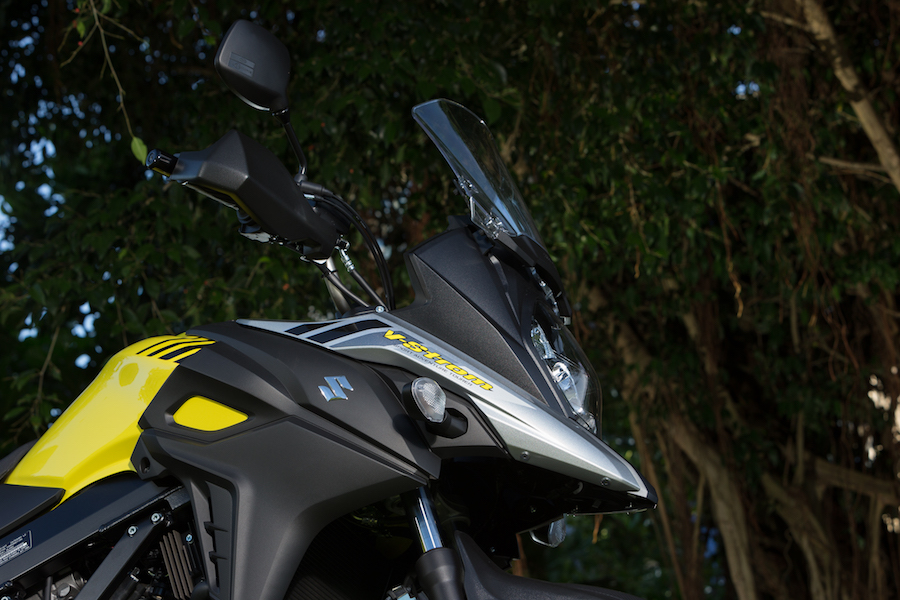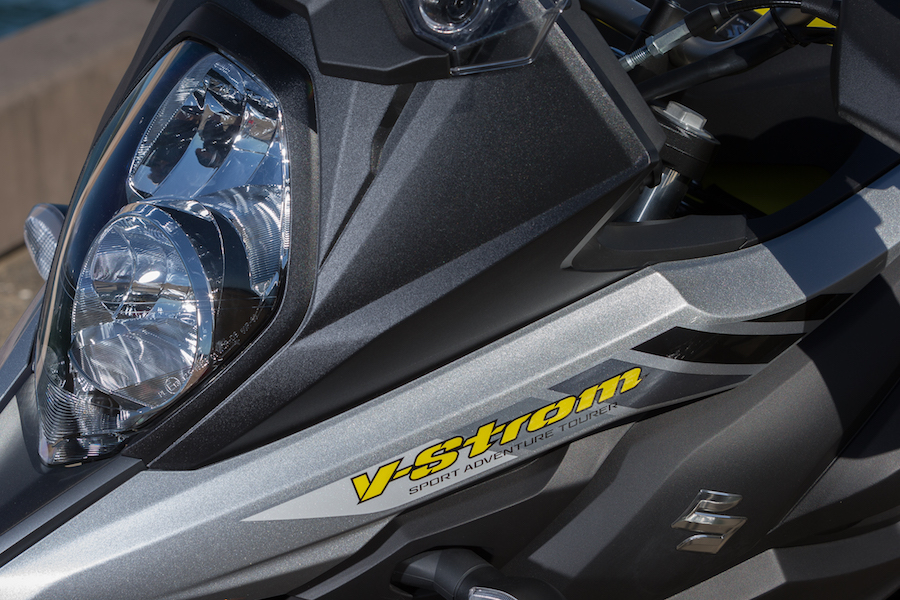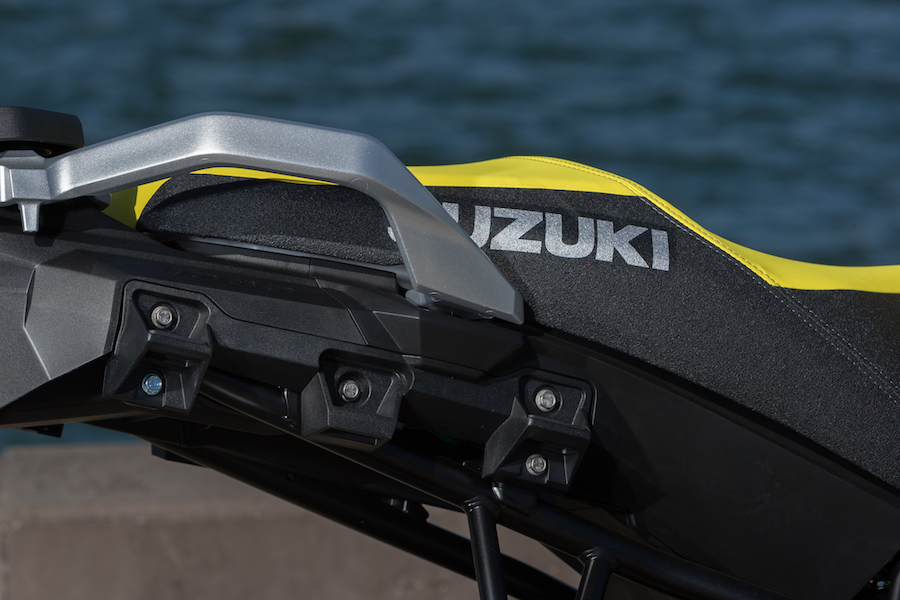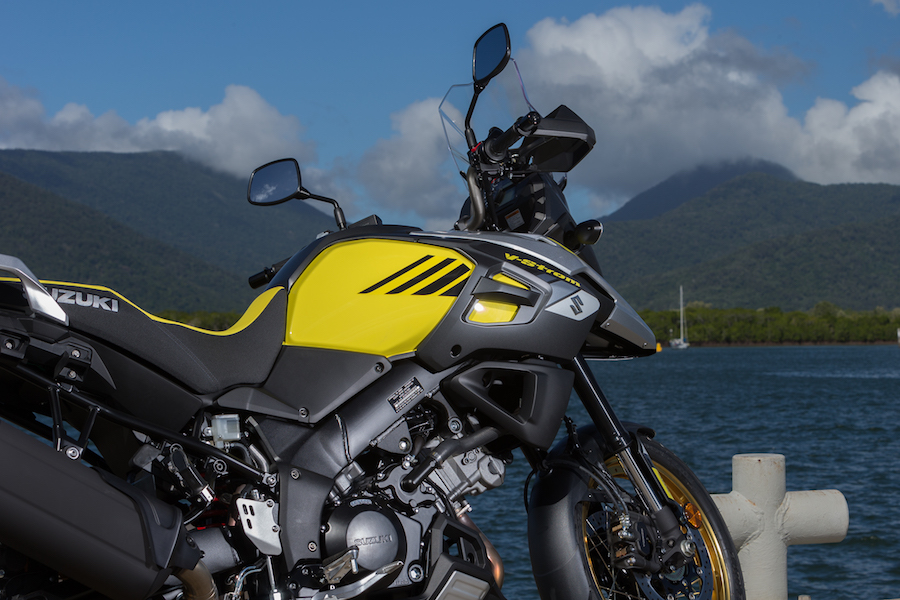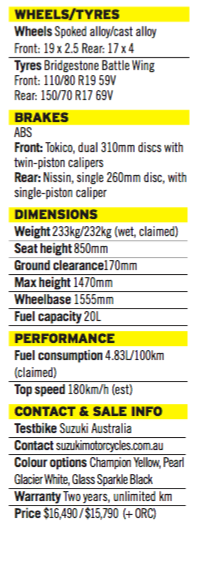How the hell was this bloke from Cape York Motorcycle Adventures, on his Suzuki DR-Z400 complete with a long-range tank and knobby tyres, meant to keep up with a bunch of mad journos on road tyre-shod Suzuki V-Strom 1000s, through the delightfully twisty Daintree Forest?
We were in Cairns in Far North Queensland about to sample Suzuki’s latest 650cc and 1000cc adventure bikes and I was a bit confused. We’d been advised the planned route would consist of 60 per cent road riding with the other 40 per cent made up of simple dirt roads, so why did Roy Kunda opt for the DR? And when I asked if he’d be okay, why did he look up, smile and say ‘no problem’?
I soon learnt the so-called 60 per cent road actually meant closer to 10 per cent, and that our lovely posse of just run-in bikes was about to get quite a workout.
Day one and the weather was perfect with a balmy 33ºC forecast. The plan was to make our way north from Cairns to a campsite at Palmer River.

The last V-Strom I had ridden was the 2014 version of the 650 XT and it was a bike I had an instant attraction to. With the huge modifications made to the 2017 model, I wanted to jump on one straight away to see for myself if Suzuki could make a great bike even better.
The major differences of the new 650 compared to last year’s bike are easy to see. First, it’s had a complete makeover from head to toe. It’s now a lot closer in appearance to its aggressive-looking big brother, sporting the same style beak that
was made famous by the DR Z 800 that competed in the Paris-Dakar with Gaston Rahier on board many years ago.
Suzuki says it has revamped the styling to make it easier for people to pick the 650 as a member of the V-Strom family; by doing so, it has made an even more desirable bike than last year’s. The XT also now comes standard with handguards and a plastic bashplate, which is a nice bonus because last year they were add-on extras.
The rear of the bike has been totally redesigned to match the look of the litre version, and includes a luggage rack as standard.
Integrated luggage can be fitted on this model, too, which wasn’t necessarily the legal truth with the old 650. Suzuki knew it had a problem with the width of the old bike with luggage fitted, and nothing but a total rethink was needed to suit the Australian thirst for adventure and slimness.
The price of the panniers are $1799 and the top box is $1190. The new system not only looks sharper but functions better, and helps the bike handle as if the panniers weren’t there. I was lucky to get a stint on the bike with a luggage set fitted and was super impressed that it didn’t alter the balance of the bike, and it was still easy to mount and dismount.
The handlebar height is good on the 650, though adjusted too far forward for my liking. It’s a personal choice, but when we were on the dirt heading up to Palmers Creek to camp for the night I was standing a lot on the pegs. That confirmed my initial feeling, and if I had a long-termer I would get the tools out as there is plenty of scope for change without spending any money.
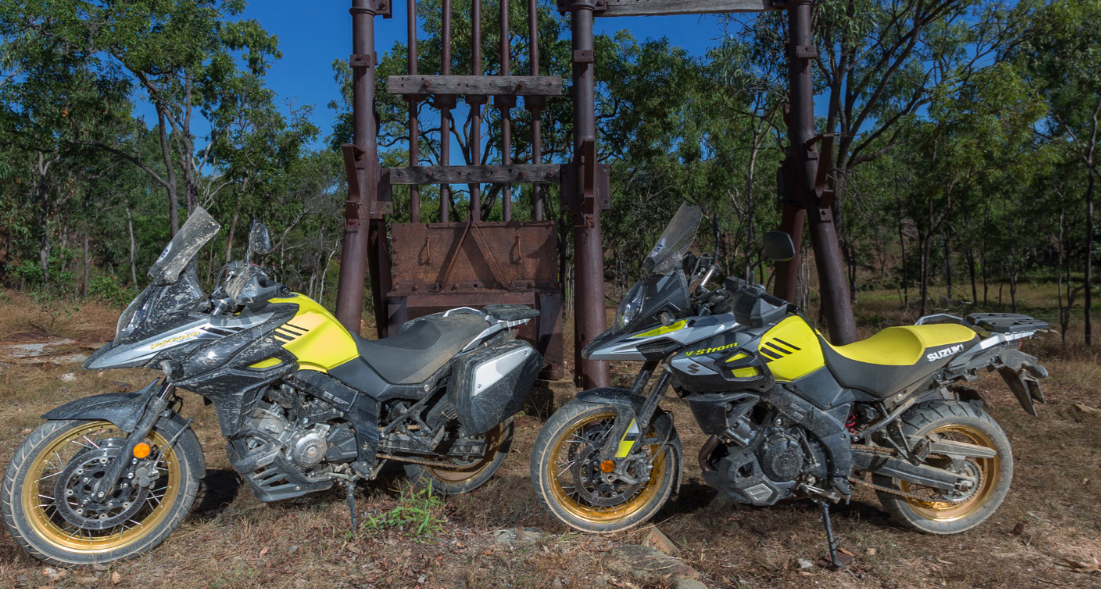
The 650 has also been upgraded technically with the same dash as the 1000 and the addition of two-way adjustable traction control that can be turned off if you want to have some fun.
The traction can be adjusted on the fly and it’s very simple when you get the hang of it – just a quick touch of the mode button and then tap the adjuster switch up or down with a closed throttle to get the setting you want. It works well in both settings and is more of a ‘save your bacon’ type feature than a performance aid like we find on modern sportsbikes.
Suzuki’s one-touch easy-start system makes its way onto the bike, and there’s a charging port in the cockpit now. The V-Strom 650 also has the low-rpm assist program, which raises the revs slightly as you release the clutch in first gear.
This reduces the risk of a stall and works so well you almost can’t notice it.
Under the new exterior remains the same faithful frame and suspension package there always was. No need to change this because for the money it would be difficult to find a better-handling bike. It feels light to ride and very nimble on change of direction on the asphalt, and that same road manner transfers to the dirt.
The panel under the seat that adorned last year’s model has been replaced by a new slimmer version placed slightly forward, facilitating an overall reduction of 5mm in the width around the crotch area. Sitting on the bike, it was quite easy to reach the ground and that has always been one of the positives of the V-Strom – low height makes it easy to balance at a standstill.
The front suspension is unchanged, having a non-adjustable Kayaba fork with a stroke of 150mm. For a conventional fork, it works reasonably well at absorbing bumps and gives a very compliant ride.
When you push beyond the parameters of the bike, however, you start wishing for the upside-down fork of the 1000 because it’s just better quality. A couple of times on some rough road sections – and only when I was over-riding the bike – I had some moments where the front cried enough. It started to skip across the top of the surface and let me know to back off.
In the dirt sections I thought the fork worked well for the travel on hand and my only criticism was that it bottomed out a bit. I stress that under normal riding the fork is great; you can get better, but it comes at a price.
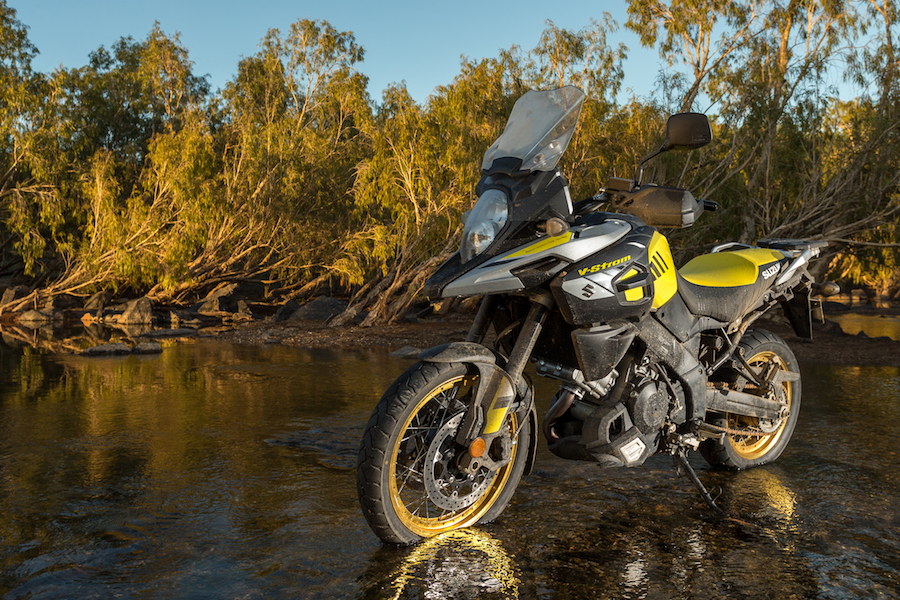
Like the old model, the rear suspension has a nifty hydraulic spring preload adjuster knob on the right-side of the frame and adjustments can be made without any tools. All it takes is a twist of the wrist and you can wind preload on or off at will. There is no compression damping but a rebound clicker is available if you feel the need. I personally thought the 650 rear shock was set up well in the standard form and I didn’t play with it at all – either on road or off.
The braking system is like last year’s, with twin-piston calipers biting 310mm discs up front and a 260mm single disc with a single-piston caliper on the rear. The front brake has good stopping power but you need to really pull the lever to get the most out of them. On the upside, it’s easy to modulate the brake, meaning a less-skilled rider will feel more at home with this set-up.
The Bosch ABS unit is unchanged from the previous model and works well on the road. Sadly for the adventurers among us, you can’t switch it off. The off-road braking capability could be improved considerably if you could figure out a way to deactivate it, and that’s probably something for Suzuki to look at in the future.
The engine harks back to the design of the first SV650 in 1999, but there’s been big changes over the years – and especially this year to meet Euro 4 emissions. Suzuki has changed 60 components, not only to make this bike run cleaner, but also to give better economy and even a little more power.
The pistons are new, there have been head modifications and the introduction of higher-quality spark plugs to help the gasses burn better. A new exhaust pipe does its bit as well by saving weight, and for the first time this year it houses the catalytic convertor, giving a cleaner look to the underside of the bike.
The new engine’s power characteristic can be best described as sweet and easy – almost joyful to use. You can cruise along all day in fifth or sixth gear; or if things get serious, click it down, rev it and away you go.
By the time I got to camp on the first day of our trek I was mighty impressed by both the standard V-Strom 650 and the wire-wheeled XT version.
It is possible to adventure this bike, but if I owned one there are a few things I would change before heading off on my trip of a lifetime.
Firstly, I would fit more off-road-oriented tyres to really make its prowess shine. A metal bashplate would be a must to protect the oil filter sticking out in the breeze. I’d also add the aftermarket screen and the new slim-type heated grips, which now come as a genuine accessory.
After a hell of a hard day’s ride, all six V-Stroms – both 1000s and 650s – arrived at our campsite without a spanner needed to be spun. There was a lot of banter traded around the campfire that night and many tall stories were told, but this story wasn’t over.
Most of the night I was tossing and turning under the stars, kept up by the sniffing and snorting of horses (at least I hope it was horses).

I think one even gave me a lick. Another thing that kept my mind running during those wee hours was a question: why is it that the V-Strom 650 outsells the 1000 by more than two to one? Sure, some of the uptake is thanks to the LAMS version of the 650, but it’s a minor part.
Being an alpha male, I was sure I would be a 1000 customer. To confirm my thinking, the keys I grabbed in the morning were those of the newly introduced 2017 1000 XT.
Yes, finally the wire-wheeled 1000 is here. I don’t know what it is about the wires, but I do like them and they are popular. Surprisingly, they’re heavier than the cast wheels, but in this class one or two kilos isn’t the end of the world, so it’s more a matter of taste.

Now, whereas the 650 has had a massive makeover, the 1000 has been merely ‘enhanced’. That means it’s mostly the same as last year, except for some special mods.
The most important change is a lighter ABS system, which uses an IMU (Inertial Measurement Unit) to trace the axis of the bike and alter the ABS setting to suit.
The new ABS is a big improvement, with the newer technology affording better butt-saving ability in dire situations. It can judge if you are braking upright or on a lean, altering the force as needed. This is matched with four-pot calipers that come straight off the old-model GSX-R1000, which provide amazing stopping force, I couldn’t fault the system on tarmac. Even on the off-road run to the old township of Mount Molloy, the system worked well in the dirt considering it was never designed to be there.
The rest of the changes could best be described as refinements. A new screen is fitted (49mm taller) that is adjustable on the fly with a great ratchet system. And when you put it in the fully forward position it provides good protection. As on the 650XT, handguards and cowling under the engine now come as standard on both 1000 models. The hand guards do provide a good amount of protection from the weather and debris, but I would still like to see heated grips as standard for those of us who live in colder climes.
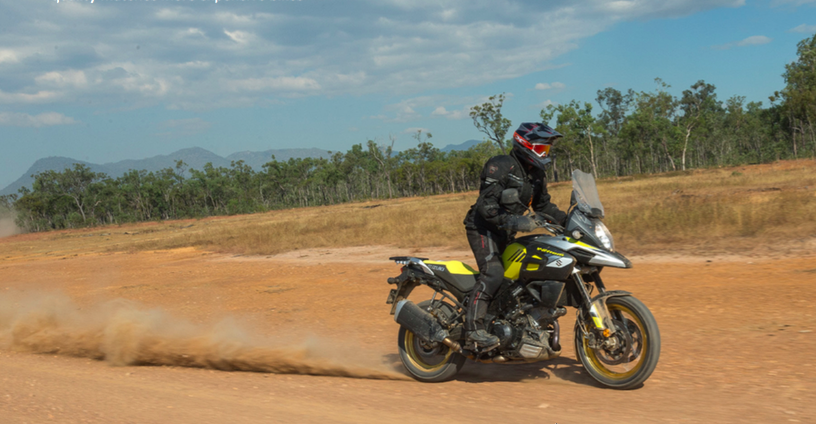
Like the 650, the 1000 has been upgraded with the Suzuki easy-start system, as well as the firm’s low-rpm assist to support clutch engagement and riding at low revs.
There’s also been some cosmetic tweaking of the beak, and the XT model sports a set of tapered alloy handlebars.
The chassis, suspension and running gear provide the same good handling as before, although there are some slight differences in the donk. The old engine was only Euro 3 compliant, giving Suzuki two options: modify 60 parts as it has on the 650 and gain more power, or do the minimum and lose a tiny bit. It chose the latter course, modifying the ECU software and exhaust to meet Euro 4. So the 2017 bike has 2Nm less torque than the outgoing model. Can you feel it? No. And does it matter? No.
And I did answer my own question about the 650 sales advantage over the 1000. My run on the 1000 down to Cape Tribulation proved that it’s a beaut brute, giving the rider some great thrills. It’s got lots more power than the 650 and is perfect for the show ponies among us. It’s harder to ride and slightly less nimble than the 650, but has better suspension and brakes. And while the screen and ergos are better on the 1000, it’s also $4500 more expensive if comparing the XT versions.
I guess the thrill of owning any big bike is that untamability factor, the feeling that you are always on the edge, and the 1000 takes you much closer to that edge than the 650.
Which one would I buy? I don’t know, but I would consider both.
TEST STEVE MARTIN PHOTOGRAPHY ANDREW GOSLING

